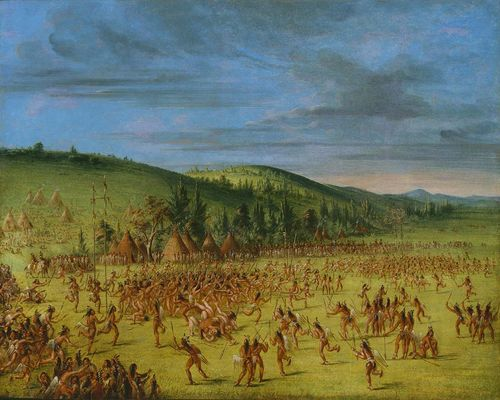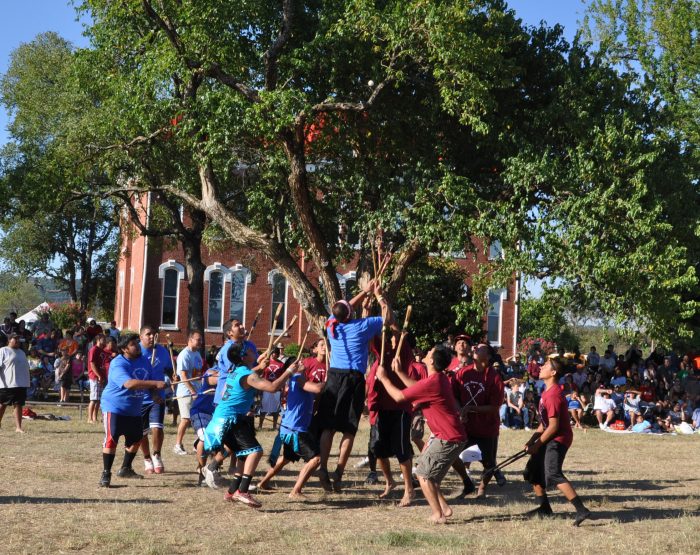A gift of empathy: Happy St. Patrick’s Day from the American Indian Museum
The Irish Potato Famine of 1845-1849 caused untold misery when the potato crop in Ireland failed in successive years. The famine, the worst to occur in Europe in the 19th century, compelled hundreds of thousands to emigrate to the United States and forever changed the culture of our country. It also provoked a remarkable act of of empathy that shaped the tribal culture of the Choctaw Nation.

This picture shows a migrant ship setting sail to America from Ireland. Such vessels were called “coffin ships” because disease ran rampant in the overcrowded conditions and many immigrants did not survive the voyage. (Illustrated London News – pub 6th July 1850. Photo by Illustrated London News/Hulton Archive/Getty Images)
On St. Patrick’s Day, Judy Allen, senior executive officer of tribal relations for the Choctaw Nation, tells the story of a gift from the people of the Choctaw Nation to the people of Ireland during the Irish famine.
The Choctaw people have a history of helping others. Only 16 years after their long, sad march along the Trail of Tears, the Choctaws learned of people starving to death in Ireland. With great empathy, in 1847 Choctaw individuals made donations totaling $170 [the equivalent of several thousand dollars today] to assist the Irish people during the famine. It was an amazing gesture. Though they had meager resources, they gave on behalf of others in greater need.
In 1995, Irish President Mary Robinson, later UN Commissioner for Human Rights, visited the Choctaw Nation of Oklahoma to thank the Choctaws for their generosity toward the Irish, a people with whom she noted their only link was “a common humanity, a common sense of another people suffering as the Choctaw Nation had suffered when being removed from their tribal land.”

George Catlin (1796–1872). Ball-play of the Choctaw: Ball-up, 1846–50. Oil on canvas; 65.4 x 81.4 cm. Gift of Mrs. Joseph Harrison, Jr. Smithsonian American Art Museum 1985.66.428A. In 1834 Catlin watched Choctaws playing stickball during his travels in Indian Territory (present-day Oklahoma).
President Robinson also acknowledged the many Choctaws who have visited Ireland to take part in commemorating the Famine Walk. “Earlier in the month I met one of the members of the tribe, the artist Gary Whitedeer,” she said. “He explained to me that taking part in that walk and remembering the past between the Choctaw Nation and Irish people and relinking our peoples is completing the circle. I have used that expression recently at a major conference on world hunger in New York. I spoke of the generosity of the Choctaw people and this idea of completing the circle.”
This charitable attitude resonates still today when crisis situations occur across the world. In 2001, tribal people made a huge contribution to the Firefighters Fund after the Twin Towers attack in New York City and have since made major contributions to Save the Children and the Red Cross in 2004 for tsunami relief, in 2005 for Hurricane Katrina relief, and more recently, for victims of the Haiti earthquake. Good works are not exclusive to humanitarian organizations and funds. The Choctaw Nation received the United States National Freedom Award in 2008 for the efforts made in support of members of the National Guard and Reserve and their families. There are countless stories of Choctaw individuals who have looked past their own needs to help their neighbors.

Traditional stickball games are still played today. Photo by Judy Allen, senior executive officer of tribal relations for the Choctaw Nation. Courtesy of the Choctaw Nation of Oklahoma.
This is an edited version of a post that was originally published by the National Museum of the American Indian’s blog.
Posted: 17 March 2017
-
Categories:
American Indian Museum , Feature Stories , History and Culture



